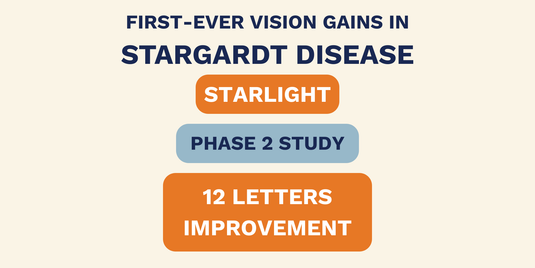At A Race Against Blindness, we’re always watching for scientific breakthroughs that could bring new hope to families living with rare retinal diseases. One such development was just announced by Nanoscope Therapeutics, and it’s a milestone worth sharing.
Nanoscope has published the results of their STARLIGHT Phase 2 clinical trial in eClinical Medicine (part of The Lancet Discovery Science), marking the first and only clinical trial to date to demonstrate vision improvements in people with Stargardt disease — a genetic eye condition that currently has no approved treatment.
What is Stargardt Disease?
Stargardt disease, sometimes called juvenile macular dystrophy, affects more than 40,000 people in the U.S. and can leave over 20,000 legally blind. It causes the gradual loss of central vision when light-sensing photoreceptor cells in the macula break down. For many, vision loss begins in childhood or adolescence, and until now, options for treatment have been non-existent.
Inside the STARLIGHT Trial
Study design:
-
Phase 2, open-label study
-
Six participants with severe vision loss from Stargardt disease
-
Single, in-office intravitreal injection of MCO-010 (Nanoscope’s gene-agnostic therapy)
-
Follow-up for 48 weeks
Key results:
-
Patients with macular atrophy confined to the center of the retina gained an average of +12 ETDRS letters (about 2–3 lines on a standard eye chart) without visual aids — and +32 letters with a wearable low-vision aid.
-
Some participants began noticing vision improvements as early as four weeks after treatment.
-
Benefits were sustained throughout the 48-week study period.
-
No serious adverse events were reported.
Why MCO-010 Is Different
Unlike many experimental retinal therapies, MCO-010 is gene-agnostic, meaning it does not require patients to undergo genetic testing to qualify. It works by activating remaining bipolar retinal cells to detect light, even after photoreceptor cells have been lost. The treatment is delivered in-office with a single injection — no surgery, no repeat dosing.
This design could make the therapy accessible to a broad range of patients and integrate easily into existing retina clinic workflows.
What’s Next: Phase 3 STARGAZE Trial
After meeting with the FDA, Nanoscope plans to begin a Phase 3 registration-enabling trial for Stargardt disease by the end of 2025. The STARGAZE study will:
-
Enroll ~60 patients at multiple centers
-
Compare MCO-010 against a sham control
-
Measure changes in best-corrected visual acuity (BCVA) as the primary endpoint
-
Include shape recognition testing under multiple lighting conditions as a key secondary endpoint
-
Report top-line results in 2027
Why This Matters to the Rare Retinal Disease Community
For families affected by vision-robbing diseases — whether Stargardt disease, Bardet-Biedl Syndrome, or retinitis pigmentosa — every step forward in research is a step toward hope. Therapies like MCO-010 represent a potential paradigm shift: vision restoration for conditions once deemed untreatable.
We’ll be watching this program closely and will share updates as the STARGAZE Phase 3 trial moves forward.
Sources:



